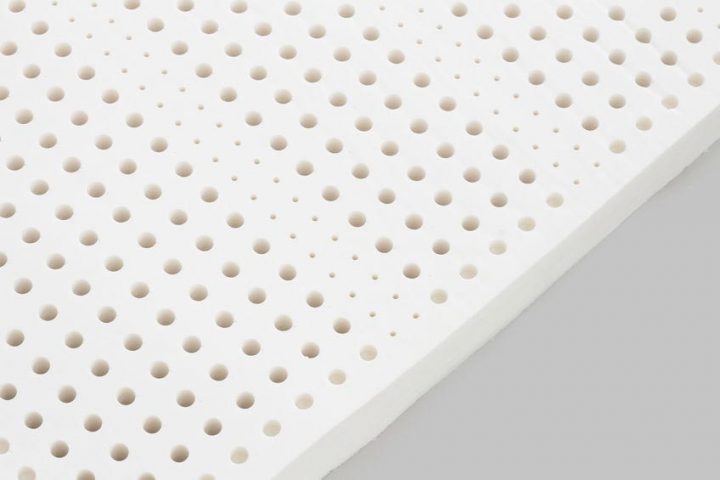 Latex pillows have recently become quite popular as an alternative to traditional pillow types. I decided it was time to try out one of these interesting pillows to see what all the hype was about. A few weeks ago, I perused the latex pillow reviews at Amazon and made a choice. I paid $45 for it, which seems completely reasonable for something that you spend a third of your life on.
Latex pillows have recently become quite popular as an alternative to traditional pillow types. I decided it was time to try out one of these interesting pillows to see what all the hype was about. A few weeks ago, I perused the latex pillow reviews at Amazon and made a choice. I paid $45 for it, which seems completely reasonable for something that you spend a third of your life on.
What’s a latex pillow anyway?

Latex is extracted from a rubber tree.
Latex is a popular material for use in a pillow because it’s durable and supportive. It will not collapse under the weight of your head like softer pillow filling like down or memory foam.
Latex is extracted from a Hevea-Brasilienis tree, also known as a rubber tree. Being that it isn’t made from a cocktail of strange petrochemicals, latex pillows are often marketed as being a natural and safe alternative to other pillow types like memory foam.
100% Natural Latex vs. Latex Blends
Most latex pillows fit the ill-defined term, “natural,” but many of these actually consist of a blend of latex and other materials like polyurethane foam to cut down on cost. Unfortunately blending polyurethane foam with latex will reduce durability. In addition, there is evidence that polyurethane releases volatile organic compounds that can cause allergic reactions such as skin irritation and breathing issues.
Manufacturers can call their product, “natural latex” as long as there is a certain percentage of natural material in the synthetic blend. I recommend you look for products that are labeled “100% natural latex.”
Some of latex pillows’ benefits are exaggerated.
Are latex pillows hypoallergenic?
Marketers can use the term “hypoallergenic” with impunity due to a lack of government oversight. Pillows labeled “hypoallergenic” are generally is no better at preventing allergic reactions than any other pillow type. No cohesive evidence exists to suggest that latex pillows are better at preventing allergic reactions.
Less than 1% of us are actually allergic to latex itself. That said, latex allergies are often quite serious (they can cause anaphylactic shock), according to the American Latex Allergy Association.
Are latex pillows dust mite resistant?
Some claim that latex pillows are “dust mite resistant.” This is false. It is true that a pack of hungry dust mites will not feast on a brand-new latex pillow. But, just like other pillows, a latex pillow will inevitably get covered with bits of human skin, hair and other organic materials that dust mites love to eat.
My Latex Pillow Experience
First Impressions
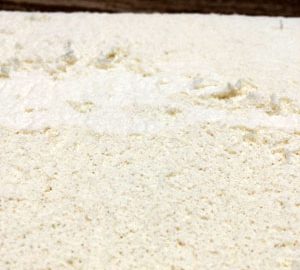
Surface of a Latex Pillow
When my new latex pillow arrived, it wasn’t quite what I expected. Molded into a shape mimicking a traditional rectangular pillow’s, it fits nicely inside a standard size pillow case.
It wasn’t quite as spongey or soft as I expected it to be. The latex was a solid loaf of a dense, rubbery material that isn’t moldable or adjustable in any way.
Latex pillows are pretty hefty, relative to traditional pillow types. I’m accustomed to sleeping on a buckwheat pillow, which weigh as much as 9 pounds so it didn’t feel overly heavy to me, but some might find a latex pillow a bit unwieldy.

Pieces of latex were flaking off my pillow.
The manufacturer claimed that the pillow “is made with a unique pinhole design, which provides an unprecedented level of breathability, allowing sleepers warmth in the cool seasons, and coolness in the hot summer months.” Despite this claim of it having small holes in it, when I removed the cover I found just a solid piece of latex with no perforations.
This pillow was supposedly 100% natural latex pillow and not a blend of less durable poly foams, but it appeared to be falling apart. Its surface was irregular and small pieces of the latex were flaking off. I doubt that the unattractive surface had anything to do with the comfort levels, but it was disconcerting – would the pillow fall apart over time?
Despite the assertion that latex is more durable than other pillow fill types, a few of the reviews I read on Amazon suggested that they might not last. We’ll see about that…
Unfortunately latex has a very distinct rubber-like odor.
They smell like… well, latex gloves. I didn’t find it particularly disruptive to my sleep, but my wife found it annoying. Some users report that the smell goes away after a few days, but I’ve had mine for several weeks now and it still has a powerful odor.
*Edit 12/30/15 7 months later, the rubber odor is as strong as ever.
Night 1
I am a side sleeper and I generally need a thicker pillow to fill the space between my head and neck. I immediately discovered that my latex pillow was too thin. My head and neck bent slightly downward at an uncomfortable angle. I found that I was unable to squish it into the shape I desired; it would immediately pop back to its original shape. I woke up with a slight neck pain.

Latex pillows often are manufactured with small holes in them to allow for improved air flow and breathability
Night 2
I needed just a bit more loft to achieve a neutral sleeping position in which my spine was aligned in a straight line with no upward or downward bends. Before my second night on the pillows, I placed a folded blanket under it. This helped a bit, but keeping a blanket folded under my pillow is definitely not a good long-term solution. Were I convinced that latex pillows were for me, I’d need to find a thicker one. The manufacturer claimed that “the item will flatten after use” so it might be best to find one that is initially a bit too thick.
Does a latex pillow stay cool?
Despite that manufacturer’s claim that the latex pillow was breathable, I found that it trapped and retained my body heat. I suspect that a latex pillow with holes in it to allow air to pass through it might help, but mine was a solid impermeable piece of latex. It needed to be repeatedly flipped to the cool side.
Verdict: I wasn’t very impressed with the latex pillow I tried.
It can take awhile to get used to a new pillow, particularly when it’s as unique as latex. I gave it an honest try, but after a couple weeks, I had to give up on it.
- It was too thin to provide adequate support. Some brands are certainly thicker than others, so if you find one with the appropriate loft, this likely would not be an issue for you.
- It wasn’t as breathable/cool as some other pillow types.
- It wasn’t moldable or adjustable. Not being able to change the shape to fit my head and neck was frustrating and in the end, it was a deal breaker. No matter how I pushed, smoothed and squeezed, it’d bounce back into it’s original rectangular shape. I just couldn’t make it comfortable.
Some latex pillow types are actually filled with small shredded pieces of latex. As the name suggests, the latex fill is torn into tiny pieces, which would allow the pillow to be moldable. Shredded latex can be added or removed to change the loft provided the case has a zipper. I suspect that a shredded latex pillow would offer a much better experience. I’ll reserve judgement until I get around to testing one. Perhaps I should just tear up the latex pillow I already own!
For most people, I think that there are better options, like our own Hullo™ buckwheat pillow! Give them a try and I think you’ll agree that they’re superior to other pillow types. Don’t take my word for it — check out these customer reviews.
*Edit 8/9/16* I bought a shredded latex pillow! Read my review here.
Read More: A Hypoallergenic Pillow Should Be Judged with Skepticism

Side sleepers are best using firm, high loft pillows that encourage neutral alignment of your spine.
Your pillow’s job is to fill the space between your head and your mattress while keeping your body in what’s called a “neutral sleeping position.” When your body is positioned in a neutral sleeping position, all the bits and pieces in your back are kept in in their ideal positions, preventing unnecessary pressure on your discs, muscles and nerves. Your neck and back are generally best off when positioned in a straight line, parallel to your mattress, without any upward or downward bends.
Stay neutrally aligned and you’ll avoid discomfort (or worse).
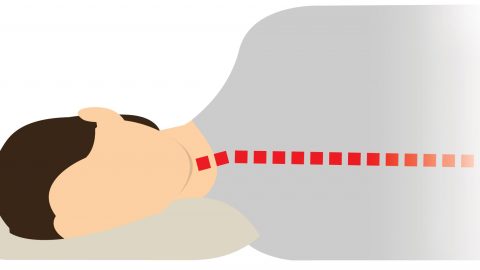
The wrong pillow can cause neck, shoulder or back pain.
Side sleepers will be most comfortable on a firm or extra-firm pillow. Softer pillow types like down tend to collapse under the weight of your head during the night. This loss of support will cause your head and neck to bend downwards, resulting in unnecessary strains that can lead to neck or back pain.
Additionally, side sleepers are advised to use a high loft (thick) pillow. This is simply because there is more space to fill between your head and the mattress when on your side than when on your back or stomach.
What are the best firm pillows for side sleepers?
No single pillow type works for all side sleepers. Fortunately we have lots of choices… a few too confusing many perhaps! Many different types can provide the comfort you need as long as they’re relatively firm and thick.
Your side sleeper pillow should:
- provide enough loft (height) to keep your spine straight. However, it isn’t so thick that it bends your neck upwards out of alignment.
- provide consistent and even support throughout the night. The fill does not slowly collapse on itself under the weight of your head. It conforms to your head and neck without uncomfortable pressure points.
- stay cool. Many pillow filling types like memory foam absorb and retain body heat making them uncomfortably warm. Breathable pillow filling types like shredded foams, buckwheat or millet hulls go a long way to to keep you comfortably cool all night long.
- be comfortable. Ultimately, it’s best to trust your instincts. If a particular pillow works well for you, stick with it.
Bonus Feature: Adjustability
Some pillows are adjustable and allow fill to be added or removed from a zippered case. Adjustable types are most often filled with buckwheat hulls or similar materials that are easily removed or added to a pillow’s case (this won’t work with most latex or down pillows). If you’ve decided on an adjustable pillow, you’ll be able to dial in the loft (thickness) exactly to your preference. With non-adjustable types you’ll need to be a little more discerning in your purchase to be sure you’ve got the proper loft to suit your preferences.
Read More: Adjustable Pillow Types: What Works Best
Sleep on it!
Squeezing a pillow inside plastic packaging at the store isn’t the way to find your ideal pillow. You really need to test drive them in your own bed. There is no substitute for literally sleeping on it.
Check the manufacturer’s return policy and make sure that you’re able to try it for at least a week. If it’s not right for you, toss it back in the box and return it. You spend a third of your life with your head resting on a pillow, so a little shopping and experimentation is absolutely worth it.
A side sleeper needs a firm pillow with enough loft to support their neck and head while keeping their body in a straight, neutral sleeping position. Above all, your side sleeper pillow should keep you comfortable and cool – trust your instincts! Experiment with different pillow types and find what works for you.

“This down pillow has ripped open and it’s so funny! My step-father, Steve, will clean up the mess when he gets home.”
Some people swear that feather and down pillows are the only way to sleep. I myself have slept on down pillows for most of my life. There’s a lot to like. They’re durable, moldable, and work reasonably well for all sleep positions.
Unfortunately feather and down pillows come with some baggage.
Cleaning can be difficult.
I have personally destroyed several down pillows and at least one comforter in the wash. I’m sure many of you have done the same. It’s quite easy to ruin things filled with feathers and down.
Thus, you have to be careful:
- Drying it too hot can scorch the fill.
- Allowing it to sit wet for too long will result in a really foul-smelling mold. Be sure not to forget them in the washer!
- Washing and drying both can cause clumping of the down clusters, which will cause your pillow to become lumpy and flat.
Proper cleaning of down and feather pillows will help them last longer, if you can do so without damaging them in the process.
Down and feathers don’t grow on trees.
That’s right, you heard it here first… down comes from ducks and geese! While you might expect humane methods for obtaining these feathers, in reality, the process likely traumatizes the birds regardless of the method.
80% of the down and feathers used in products are produced in China. The production techniques can unfortunately be grim.
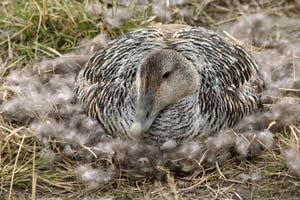
Would you tear out this poor mother’s feathers?
How do people remove feathers from birds? There are three unpleasant methods:
- After slaughter for meat – This generally involves boiling the bird’s corpses in water for several minutes to loosen the feathers. People then pluck the body feathers and separate the down by hand or machine.
- Live plucking – Every six to seven weeks before slaughter, workers capture the birds, hold them down by the neck, and tear out their feathers. This process often tears the bird’s skin. Public outrage over this practice has resulted in large retailers like IKEA and Patagonia eliminating live-plucked down from their products.
- Gathering from live birds – This method involves brushing or combing the animals to extract feathers and down that are ready to fall out naturally. This is the least traumatic of the three harvesting techniques, yet abuse is still frequent in industrial production.
Those who are concerned with animals’ well-being, should be aware that purchasing many down products may result in the poor treatment of animals.
Pillow shoppers committed to their down filling AND wanting to treat birds with respect should seek products manufactured according to The Responsible Down Standard (RDS). RDS is an independent, voluntary global standard that recognizes and rewards the best practices in the harvesting of bird feathers.
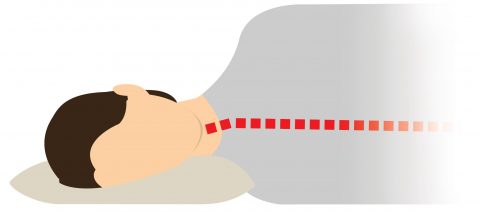 Down and feather pillows have an unfortunate tendency to flatten out as you sleep.
Down and feather pillows have an unfortunate tendency to flatten out as you sleep.
Light and fluffy is great if all you need is cuddly. However, your head and neck need proper support while you sleep to relax your muscles and align your spine in a straight line. It’s hard to get that support when your pillow turns into a pancake in the middle of the night. Down and feather pillows generally suffer from a lack of consistent support. They tend to flatten out under the weight of your head during the night causing a downward bend in your neck. They require frequent refluffing and adjustment to maintain loft and support.
Feather and down pillows retain heat.
Manufacturers frequently use feather and down filling as insulation in comforters and sleeping bags. It is terrific at keeping the warmth in and the cold out. Unfortunately that isn’t ideal in the context of pillows. Feather and down fill types retain body heat, which can make your pillow hot and uncomfortable, particularly during the summer months. The fill can restrict free air flow preventing heat from escaping. Repeatedly having to flip to the cool side of your pillow is not conducive to good sleep. By the way, that mold I mentioned… It loves the savory conditions of your sweaty down pillow!
NOTE: Contrary to a vocal (and misinformed) minority, allergic reactions to feather and down pillows are rare.
People often blame down for causing allergic reactions.It turns out that genuine feather allergies are quite rare. Dust mites or mold, both of which can thrive inside a down pillow, actually cause most reactions. Down feathers tend to become more allergenic with age – they slowly become more and more contaminated. For this reason, some recommend that down pillows be replaced as often as every 6 months. That can get pricey in a hurry!
Try this (very different) alternative to down and feather pillows…
I would have been stuck with my sad squishy down sack forever, but a friend’s recommendation led me to try a buckwheat pillow. I wasn’t an instant convert; it was very different, so it took some getting used to. But, after about a week, I was sleeping much better. I tossed out my down pillow. A year after that I was manufacturing my own buckwheat pillows. Yes – I love them that much! Don’t take my word for it. Our customer’s reviews speak for themselves! I love this testimonial from a feather pillow convert:
“As far back as I can remember using a pillow at night, I’ve used a feather pillow. Pillows stuffed with the softest down have been my default, my go to. I haughtily looked down on pillows of any other type. This was even though I’d been growing more dissatisfied with my feather pillow’s tendency to wake me in the middle of the night because it’s lofty support had degraded and squished away through after a few hours…
The first week was difficult. I was so used to the soft, plushness of feather pillows: the buckwheat pillow felt like a slab of concrete in comparison. But, then the second week hit. By then, my muscles were well adjusted. The pillow start to feel supportive rather than hard. I was a convert! This pillow is great. It excels at all-night-long support and good breathability. Unlike my feather pillows of the past, this pillow works with/for me, rather than against me. What a fantastic pillow!” –Geoff, verified Hullo customer
Looking for other alternatives to down and feather pillows? Check out our guide to types of pillows available.

The king’s royal pillow is far too small!
There are few things as awesome as falling into bed after a long, tiring day and laying your head on that perfect pillow. While the term “perfect” is different for everyone, you know exactly what I’m talking about. It’s that pillow that’s just the right thickness and consistency to keep you comfortable as you drift off into deep sleep.
King size pillows are ideal for those who like to stretch out and make the most of the space their bed offers.
King Size Pillows:
- are made for your king-sized bed. Instead of using three queen size pillows, you can use two king size pillows for a good night’s sleep. They’ll also fit into your designer king size pillowcases.
- are BIG and comfortable. Roll over and keep rolling! You have a comfortable head space no matter how much you move around.
- can serve a dual purpose as a body pillow. Many side sleepers rest better with a body pillow between their legs; it improves back support.
A King Size Buckwheat Pillow Can Help You Get Better Rest.
If you’re looking for a king size pillow that can offer you a night’s sleep like no other, consider a buckwheat pillow.
Buckwheat pillows offer several benefits:
- Better Breathability – If you’re a hot sleeper, you’ll love sleeping with a buckwheat pillow. The hulls of the buckwheat allow for excellent air flow, keeping you much cooler at night.
- Good Support – Whether you sleep on your back, side, or stomach, a good pillow provides solid support for your neck and back. The buckwheat hulls conform perfectly to the indentation of your head and neck, offering firm comfort that won’t quit.
- All Natural – Buckwheat hulls are harvested from the buckwheat plant, making them a natural, safe alternative to polyester, memory foam, or other synthetic fibers that contain potentially dangerous materials.
- Long-Lasting – With proper care, your buckwheat pillow can last many years. Plus, buckwheat pillows are made to have the filling removed and replaced — the buckwheat hulls are very affordable, not to mention 100% renewable!
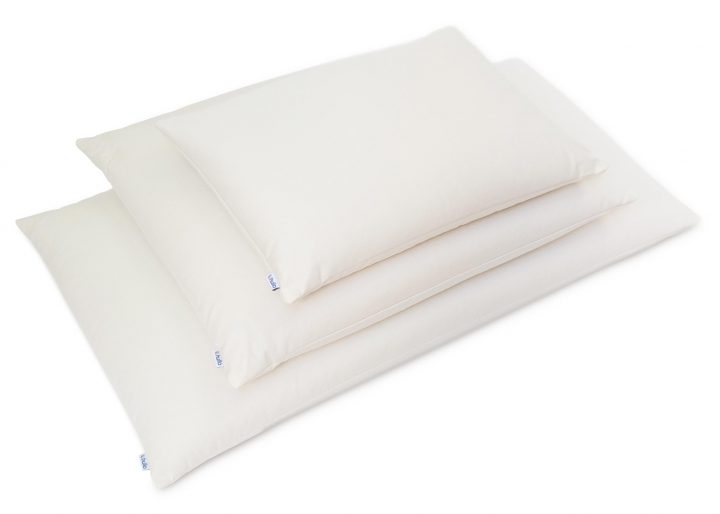
Hullo Buckwheat Pillow Is Available in King Size.
A king size Hullo buckwheat pillow offers terrific comfort and support combined with clean, natural, and organic materials. Hullo conforms to the shape of your neck, back, or body, giving you all the support you need no matter what your sleep position. Hullo also keeps you nice and cool at night. Its 100% organic cotton shell and all-natural filling helps you avoid exposure to toxins and chemicals.
With a king size Hullo buckwheat pillow, you can give yourself a good night’s sleep—every night! Give Hullo king size buckwheat pillow a try for 60 nights. If you don’t like it, send it back to us for a refund.
 A very important part of your child’s health is her sleep. Children need plenty of quality sleep in order to grow and lack of it can lead to cognitive and behavioral issues. A school-age child needs roughly 10 to 11 hours of sleep per night. This simple fact means that almost half your child’s life is spent on her pillow… A pillow that could potentially expose her to toxic materials.
A very important part of your child’s health is her sleep. Children need plenty of quality sleep in order to grow and lack of it can lead to cognitive and behavioral issues. A school-age child needs roughly 10 to 11 hours of sleep per night. This simple fact means that almost half your child’s life is spent on her pillow… A pillow that could potentially expose her to toxic materials.
I’ve got two young kids, so I have done lot of shopping for children’s bedding recently. It didn’t take much research to discover that many pillows for kids and other bedding products contain hazardous materials.
The Hidden Dangers in Pillows for Kids
A few of the unsafe toxins and chemicals that exist in popular children’s pillows are:
- PBDEs and volatile organic compounds in memory foam.
- bleach and pesticides in non-organic cotton.
- perfluorinated compounds in stain and water-resistant pillow cases and sheets.
The short-term side effects for those sensitive to these materials can include headaches, sinus issues and eye irritation. The long term risks of exposure are mostly unknown, but some research shows that they include some cancer types. Why take chances?
Pillows for kids should be made with organic and chemical-free components.
Pillows consist of 1) the fabric exterior and 2) the fill or stuffing. Keep these two elements free of the potentially nasty stuff and you’ll feel at ease knowing she’s resting safe.
1. Fabric Exterior: Look for Unbleached Organic Cotton
Cotton is a terrific fiber for use in bedding. Unfortunately non-organic cotton comes with a significant disadvantage: it is grown using some of the world’s most hazardous pesticides.
“Conventionally grown cotton uses more insecticides than any other single crop and epitomizes the worst effects of chemically dependent agriculture… Cotton growers typically use many of the most hazardous pesticides on the market including aldicarb, phorate, methamidophos and endosulfan… Pesticides used on cotton– even when used according to instructions– harm people, wildlife and the environment.” Read more: Problems with Conventional Cotton Production | Panna.org
After it is harvested, it is often bleached, treated and dyed. These procedures inevitably leave behind a multitude of chemicals in the fibers. One of the most toxic substances in the home is bleach; Greenpeace warns that “bleach can contribute to cancer, endocrine disorders and other dangerous health problems.”
Prevent your child from being exposed to anything that might be harmful by choosing unbleached organic cotton fabric.
Ideally, the pillow’s fabric outer shell and its pillow case are both made from organic cotton. Some organic cotton pillows can be a bit pricey, so an economical first-step is to get just organic pillow cases.
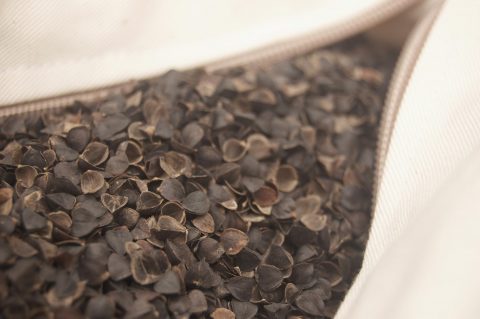
An unzipped Hullo pillow reveals its buckwheat hull filling.
2. Pillow Filling: Try Buckwheat Hulls
The benefits of buckwheat hull pillows include:
- excellent neck, head and shoulder support for all sleep positions (sides, back, stomach)
- breathability- it will keep your child at at comfortable temperature even in the hot summer months
- adjustability – add or remove fill to make the pillow thicker or thinner as desired
- durability – a good buckwheat pillow can last many years
Be aware that buckwheat pillows aren’t for babies. Children 3 years and under shouldn’t use a buckwheat pillow because there is a remote risk of choking on the hull fill should it escape the fabric case.
Hullo Buckwheat Pillow for Kids
A safe, clean pillow for kids made entirely with organic and natural materials: our own Hullo buckwheat pillow. The outer shell that contains the pillow’s fill is 100% organic cotton twill, ensuring that your child’s skin only comes in contact with toxin and chemical-free materials. Hullo’s all natural buckwheat hull fill is grown and milled in the USA without the use of any pesticides. Best of all, it’s super comfortable and we guarantee it. Try Hullo for 60 nights and if you or your child is unhappy with it for whatever reason, just send it back to us for a full refund.

“Soba” is the Japanese word for buckwheat, a plant in the same family as rhubarb and sorrel. The seeds of the plant are harvested, hulled, and ground to make noodles and other flour-based foods.
The “kawa” on the end of the word means “leather”, so “sobakawa” literally means “Buckwheat leather.” However, properly translated, it means the hulls of the buckwheat plant. Sobakawa pillows are filled with buckwheat hulls, a material that offers a lot of sleep benefits.
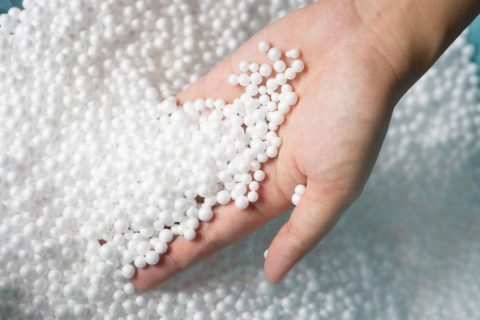
A handful of clouds… err… microbeads
Not all products labeled “Sobakawa” are genuine buckwheat pillows.
A Google search for “sobakawa pillow”, will provide links leading to a product called the “Sobakawa Cloud Pillow.” This pillow isn’t filled with buckwheat hulls, but instead uses polystyrene microbeads as a filling. It is not the same as a natural buckwheat pillow; the Cloud Pillow has simply co-opted the name for marketing purposes.
Read more: The Microbead Pillow Will Comfortably Ruin Us All
Cloud Pillow vs. the Read Deal
The Cloud Pillow product isn’t a true “sobakawa” Japanese buckwheat pillow. It’s not the best purchase. There are several reasons to avoid this pillow:
- It is not durable. They lose supportiveness–the polystyrene microbead filling breaks down quickly with use.
- The microbead fill tends to shift, causing the pillow to lose its shape easily.
- They initially release a foul-smelling gas (the smell tends to dissipate with time).
The Cloud Pillow’s polystyrene beads are produced with petrochemicals. It’s definitely not a all-natural pillow, something that most true sobakawa pillows can claim.
Buckwheat pillows, on the other hand, are much better because they:
- keep you cool at night thanks to the air flow between the hulls.
- offer terrific long-term support for your neck and head.
Compare any buckwheat pillow to the Cloud Pillow, and you’ll find that the real Sobakawa pillows win out every time!
Sobakawa Pillow: What You Need to Know
Buckwheat pillows are made with all-natural materials, including buckwheat hulls, organic cotton, etc. They’re made free of man-made fabrics, so you won’t have to worry about exposure to materials that can cause allergic reactions.
One great thing about Sobakawa pillows is that the buckwheat hulls used to fill the pillow are often locally-grown. American buckwheat is grown and harvested for the production of these pillows. By buying the buckwheat pillows, you not only support the local economy, but you do so by purchasing a fully renewable material.

Buckwheat hulls in a pillow: don’t eat these!
The benefits of buckwheat pillows are many:
- They offer excellent support — Did you know that many doctors and sleep physicians recommend buckwheat pillows? The buckwheat hulls used to stuff the pillows shift according to your position, making it easy for you to sleep with the proper support no matter what your position.
- They’re highly versatile — Whether you sleep on your side, back, or stomach, a sobakawa pillow offers versatile support. Plus, if the pillow has a zipper, you can add or remove the filling in order to make it as thick or thin as you want. You can find them in all shapes and sizes—from king size pillows to keyboard rests and sleep masks.
- They’ll keep you cool — If you sleep hot, this is the pillow for you! I tend to sleep very hot at night, and goose down pillows–while comfortable for the most part–leave me sweating all the time. With a buckwheat pillow, air passes through the hulls, cooling me down and making it easier to sleep.
In summary, sobakawa buckwheat pillows are the natural option you’re looking for. You’ll find that they’re supportive, cool, and as eco-friendly as it gets.
Our Hullo sobakawa pillow is made with 100% organic cotton, locally-sourced buckwheat, and top-notch American materials. If you’re interested in a better night’s sleep, it’s time to try buckwheat pillows! Don’t take my word for it—check out these customer reviews.
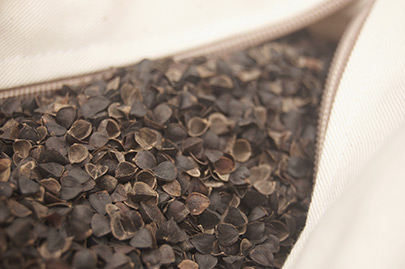
Beautiful buckwheat hulls: Hullo Pillow’s contents are revealed.
If you toss and turn at night and wake up feeling groggy and stiff, it could be because of your pillow. All your bedding affects the quality of your sleep, but nothing as much as where you lay your head and neck. The support of a quality pillow is essential to a good night’s rest.
Before replace your old pillows with more of the same type, consider the comfortable and responsible alternatives.
Did you know that the vast majority of pillows contain chemical flame retardants and formaldehyde? That they are produced under unsustainable conditions and sourced from all over the world? And that they are part of a bedding industry that lags far behind the environmentally-conscious world we are all trying to support?
Is that the kind of pillow you want to buy?
If you need new pillows for better rest and you want to make a responsible choice, consider a buckwheat pillow. This simple solution offers the best of both worlds – a better night’s sleep and true green credentials. Read on to learn how buckwheat pillows can transform your nightly ritual for the better.
What is a Buckwheat Pillow?
Let’s start with buckwheat itself. It’s not actually related to wheat, but it does produce a seed that is often milled into a flour. You may have had a tasty stack of pancakes made with buckwheat flour before. Around each seed is a hull that gets removed during processing and is typically discarded.
Asian cultures realized hundreds of years ago that the firm yet malleable buckwheat hulls made a superior upholstery filling. They started stuffing everything from furniture to pillows with buckwheat hulls, and the technique eventually caught on in the west. Unfortunately, it never became as popular as feathers or the synthetic materials we often rely on now.
It may sound exotic, but the principle behind buckwheat pillows is really very simple. Just imagine a normal pillow, but instead of having chemically-based stuffing, it has tens of thousands of tiny hulls providing firm and even support. It turns out that this abundant all-natural product is one of the most comfortable stuffing materials available anywhere.
As we have collectively become more eco-conscious, and science has proved the importance of a great pillow, buckwheat pillows are exactly the solution that many have been looking for. This time-tested alternative is the natural choice for today.
What Makes a Buckwheat Pillow Green?
Lots of products claim to be green, but when you look closer it turns out to be more of a sales pitch than a reality. Buckwheat pillows, by contrast, are a sustainable product with a miniscule environmental impact. In fact, you would have to go out of your way to make this product unsustainable.
- Buckwheat is such a hearty plant that it grows without needing pesticides, herbicides or appreciable amounts of fertilizer. That means that almost all buckwheat hulls, even the ones that have not been officially certified organic, are grown without chemicals that poison the soil and leave dangerous residue on the plant.
- The processing of the hulls is just as sustainable. They are air cleaned and air dried in a process that is energy efficient and does not add any chemicals or fertilizers to the outside of the hulls.
- Buckwheat pillows are also great for living up to rule number one of green living – use less. Buckwheat pillows can last many years with proper care, while traditional pillows quickly end up in the landfill. Refreshing your buckwheat pillow is as easy as adding new hulls instead of throwing out and replacing the whole pillow. If you have a DIY spirit, you can design and sew your own pillows and then easily fill them with high-quality buckwheat hulls. The pillows look great, feel great and come from your own materials and efforts. Its a win-win situation.
How Can a Buckwheat Pillow Improve My Sleep?
Buckwheat hulls have unique properties that no other filling material can match. The reason that they initially caught on was not because they were green, but because they were so comfortable.
- The size, shape and strength of buckwheat hulls allow them to compress under your weight but not collapse. That means when you lay your head on one of these pillows, it sinks in, but not so much that your spine is thrown out of alignment. That allows you to fall asleep faster, stay asleep longer and wake up feeling more rested.
- Buckwheat pillows also allow you to adjust and calibrate your pillow for maximum comfort. Other pillows make it difficult to remove stuffing. But since buckwheat pillows are filled with thousands of individual hulls that are accessible through a zippered side, you can add or subtract them until your pillow is just the way you like it.
- Something else to consider is temperature. Buckwheat hulls allow air to circulate throughout the pillow which helps to diffuse heat. That means you never have to search for the cold side, and your face never gets uncomfortably hot. Plus, if you are known to sleep with your face jammed in the pillow, you won’t struggle as much to breath.
Many people that make the switch to buckwheat pillows for one night end up making the switch for life. They are surprisingly comfortable, completely customizable, climate controlled and a good alternative to those allergic to traditional pillow types like down. When you wake up feeling rested, painless and ready to seize the day, you can’t argue with the results.
Now that you know that buckwheat pillows are both comfortable and eco-friendly, try one made by Hullo™.
We are committed to using the highest-quality, sustainably-produced buckwheat hulls, which is why our pillows are so comfortable. Order one today and try it for 60 days with a money-back guarantee. If you are not convinced that you are doing something better for yourself and the world, we are happy to take it back with no hassles. Just ship it back to us and we’ll refund your credit card.
Put your flat, uncomfortable, unsustainable pillows on the couch for a while, and try a buckwheat pillow instead.

78 percent of women report that sleep is more difficult during pregnancy.
During pregnancy, sleep is a fundamental need, yet 78 percent of women report that sleep is more difficult during this crucial time. While hormonal changes can be blamed for a large part of this, the unavoidable truth is that bodily changes can make it difficult to get comfortable in a horizontal position, especially during the final trimester.
While a solid eight hours of sleep each night is important for everyone, it’s especially important for pregnant women. For those growing life, experts point to the growth hormone stimulated by sleep, which is essential in growing both the placenta and the uterus. This realization brings new pressure to future moms, who may spend so much time worrying about the sleep they’re losing, they stress themselves into losing even more sleep.
Fortunately, innovation has made it easier than ever to find relief. Special techniques are now available to help women enjoy a full night’s sleep, no matter what stage of pregnancy they’re in. Here are a few of the best solutions on the market today.
Buckwheat Pillows
For women concerned about sleeping during pregnancy, a buckwheat pillow is a popular option. These pillows have the ability to conform to the head and neck, offering just the right amount of support where it’s needed most. Because the pillows allow buckwheat hulls to be removed and added as needed, a pregnant woman can customize the pillow to her individual preferences.
A buckwheat pillow can help a person during the nine months /she’s pregnant and beyond, helping her make the most of the time she can rest. Whether it’s sleeping during pregnancy or getting in a few winks between feedings after the baby is born, a buckwheat pillow can help a woman get the sleep she needs to better care for her own baby.
Body Pillows
In addition to flexible support for the head, pregnant women often find they need support for the entire body, especially as a pregnancy progresses. Maternity body pillows are specifically designed to support the areas that need it most throughout a woman’s pregnancy. The important thing to keep in mind when searching for a body pillow is that it should conform to the body’s natural shape, with multi-positional functionality to allow it to be adjusted as needed.
Since a woman’s support needs change as her baby grows, it’s important to find a body pillow that adjusts with the body’s needs. Some women prefer using multiple pillows from head to toe to achieve the same effect. Buckwheat pillows are ideal for this purpose, as well, with the stuffing being removed from one and inserted into another to facilitate more comfortable sleeping during pregnancy.
Pregnancy Wedges
In addition to comfortable pillows that conform to a person’s head, experts also recommend pregnancy wedges for help with sleeping during pregnancy. What pillows do for the head, pregnancy wedges do for the rest of the body, allowing the sleeper to place it beneath the back to maintain elevation for the upper body as the baby continues to grow. Some pregnant women have found the wedges ideal for placing between the legs for added support while sleeping on their sides. Prenatal sleep wedges are available in a variety of shapes and sizes, with optional washable covers to keep the wedge clean through multiple uses.
As a woman reaches the final months of her pregnancy, many medical practitioners will recommend she sleep on her side. By this time, the weight of the baby will be nearing its peak, making any sleep position uncomfortable as the weight puts strain on her back and hips. At this point, women usually place the wedge between the baby and the mattress to provide extra support and cushioning. If she chooses to place an additional wedge between her legs, she may find that this is effective in helping reduce hip strain, especially when done in conjunction with a stomach wedge.
Nasal Saline Sprays
Congestion is a normal part of pregnancy, leading to difficulty during the night hours. Called rhinitis of pregnancy, this condition often gets worse as a woman’s pregnancy progresses, leading to snoring and inability to breathe clearly. While a pregnant woman can’t take medications to relieve sinus issues, saline nose drops are a harmless way to relieve sinus congestion. Check with your doctor for a recommendation on the safest saline spray.
If cleaned daily and filled with fresh water, a humidifier or vaporizer can be a great way to relieve congestion at night. Pillows can also help with elevating the head to promote proper drainage. This can also help relieve heartburn, which is also a pregnancy-related problem that disrupts sleep.
Bedside Sleep Assistants
Since downing medication isn’t a safe option, women having trouble sleeping during pregnancy have found that tools like the NightWave Sleep Assistant are perfect. The device rests at the sleeper’s bedside and emits a soft blue light that rises and falls in luminance to put those in the room to sleep. The sleeper synchronizes her breathing with the light’s movements until the light grows dim and gradually goes dark. This pre-sleep ritual is designed to help participants fall asleep each night without the aid of medications.
White noise machines have also been shown to be effective in battling insomnia. Available in a variety of designs, these machines emit a solid white noise that helps drown out sounds that might disrupt sleep. Some opt for a machine that provides soothing sounds like rain or ocean waves. If outside sounds are indeed a source of disruptions, a good set of earplugs can be the best investment an insomniac can make.
Pregnancy is an exciting time in a woman’s life. By finding ways to improve sleeping during pregnancy, a pregnant woman can improve her performance throughout the day and ensure her body is in peak condition as she prepares to give birth. Additionally, she’ll be well rested for those long, sleepness nights that occur once the baby arrives.
Read More: I Can’t Sleep! What Are the Symptoms of Insomnia?

A wall of confusing options.
Are you overwhelmed with all the different types of pillows available?
There are so many different types of pillows available today that finding the right one can be downright confusing. Memory foam, down, microbead, even water pillows are an option in today’s saturated bedding markets.
Unfortunately, no single type of pillow works for everyone. We have choices – lots and lots of choices.
The various types of pillows available today are most easily categorized by what they’re filled with. A quality fabric pillow case, or shell is an important component, but its general character is dictated by the filling. Your pillow’s filling makes it feel the way it does.
Before we dive into all of the different filling options, let’s consider the consistent component of all pillows, the outer fabric case.
We recommend cotton regardless of the filling. It’s the overwhelming favorite for use in bedding products for a reason… It’s soft, breathable and cheap to manufacture. Being that the production of cotton can sometimes result in toxic chemicals being released into the environment, we encourage consumers to purchase certified organic cotton bedding manufactured to OEKO-TEX standards.
A pillow case that has a zippered opening will allow you to adjust its filling to suit your preferences. You can easily change softness/firmness and loft (height) by adding or removing filling from your pillow. Not all pillow types offer this flexibility, but if you’re willing to get hands-on you can purchase filling and a case separately for a DIY pillow!
Each pillow filling has its own advantages/disadvantages and appeals to a unique audience of sleepy heads.
I’ve summarized the most popular pillow types and their features so that you can get a sense of what might be most appropriate for you and your preferred sleeping position.
To represent each of the different types of pillows I’ve chosen a product(s) that appears to be the best of what’s available online currently. Please note that these are not my personal recommendations and I haven’t tried every example pillow in this list. Each is manufactured by a reputable brand with favorable reviews.
A signal exception: our own Hullo buckwheat pillow. We love buckwheat pillows!
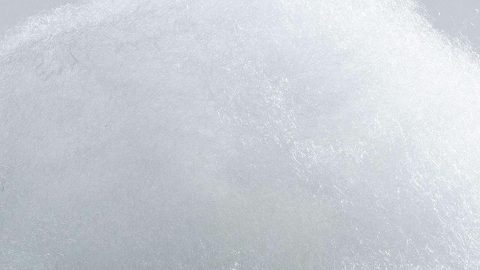
Can you see it? Polyester Pillow Fill
Fiberfill Pillows
Also referred to as Poly-fil, its trademarked name, fiberfill is the cheapest option on our list. Unfortunately it tends to flatten out with use and won’t last as long as some other types of pillows. What’s more, polyester products are manufactured using hazardous chemicals and are a significant contributor to the pollution of our environment. For these reasons, we don’t recommend them except in instances where price is your primary concern.
Polyester Pillow Advantages:
- dirt cheap
- easy to clean
Polyester Pillow Disadvantages:
- polyester fill clumps easily requiring frequent readjustment and loses elasticity with use
- short life span
- potentially hazardous to your health and the environment
Polyester pillows are best for back and side sleepers. Stomach sleepers might also appreciate a polyester-filled pillow if it isn’t too thick.
Polyester Pillow Example: Bare Home Luxury Fiberfill Pillows
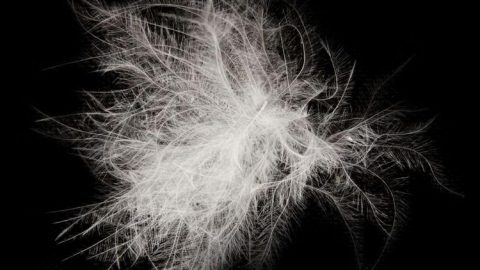 Down Pillows
Down Pillows
The undercoating of a bird’s feathers is called down. More specifically, it’s the bottom, fluffy part of a bird’s feather. Down holds its loft up to 3 times longer than synthetic alternatives and as you probably already know it is very soft.
Hungarian goose down (otherwise known as European white goose down) is considered to be the best quality. These down clusters are pure white and larger than most other types.
A real down pillow contains down only — no feathers. Many manufacturers sell a combination of down and feather fill and label it “down.” Feathers are an economical way to add volume, but often the feathers’ quills will stick through the pillow poking your pretty face (ouch!) while you sleep.
Our friend Martha Stewart is fond of these types of pillows and suggests that you purchase only high-quality down fill due to its longevity.
“I have pillows on my beds that are 10 to 15 years old,” Martha says. In the long run, good-quality down is the least-expensive way to go since it holds up better than synthetic stuffings, which generally wear out in three to four years.
15 years old? I think Martha must take really good care of her pillows!
If you’re concerned about the well-being of animals, down comes at a considerable price.
Down feathers are collected using one of three techniques: 1) post-mortem, after being killed for their meat, 2) live plucking or 3) gathering from live birds. None are humane. Read More: Down and Feather Pillows
Advantages of Down Pillows:
- moldable/malleable – a down pillow tends to hold its shape well, offering good support for your head and neck
- light and cuddly – down pillows are very light (heavy feathers don’t work very well for flying after all!) and soft
- durable – with proper care, a down pillow can last for several years
- sustainable – down is a renewable resource that is biodegradable and recyclable
Disadvantages of Down Pillows:
- requires consistent fluffing to maintain its loft
- difficult to clean
- lack of firm options
- good ones are very pricey (see below)
- the poor birds!
Down pillows work well for all sleep positions.
Down Pillow Examples:
L.L. Bean 700-Fill-Power Sateen White Goose Down Pillow
East Coast Bedding European 800 Fill Power White Goose Down Pillow
Siberian 800 Fill Power White Goose Down Pillow
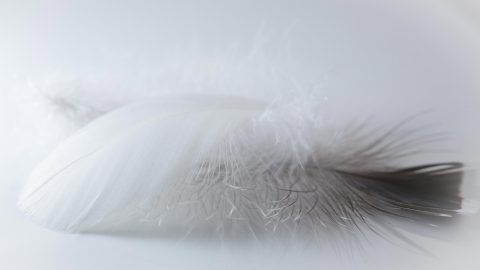
Feather Pillows
Down’s cheap little brother. We recommend you avoid these and spend the extra money on real down if you think this type of pillow is for you.
Unlike down, feathers’ quills naturally begin to align with each other or lay flat. Over time this makes the pillow become flat and uncomfortable. To prevent this, manufacturers often add down clusters to the feathers which slows degeneration. Read More: Down and Feather Pillows
Advantages of Feather Pillows:
- cheap
- light and cuddly just like down
- sustainable – down is a renewable resource that is biodegradable and recyclable
Disadvantages of Feather Pillows:
- “at least 15% of owners report a lingering and unpleasant odor.”
- requires consistent fluffing to maintain its loft due to the quills flattening
- difficult to clean
- again, those poor birds!
Feather pillows are best for back and side sleepers.
Feather Pillow Example: White Goose Feather Bed Pillow

Funky space age memory foam
Memory Foam Pillows
Memory foam is manufactured using polyurethane and several other chemicals, and it unfortunately often emits a strong chemical odor. This “off gassing” of volatile organic compounds is a common and well-documented property of memory foam pillows and mattresses. There are various reports and studies which indicate that memory foam may be somewhat toxic.
Toxicity aside, memory foam is pretty neat! If you’ve ever felt it, you know what I mean: It’s sort of magical the way it retains its shape. I suspect that it’s this “magic” that makes them so popular; people are immediately impressed with the way memory foam feels.
Recently some memory foam pillows have been rebranded “bamboo pillows.” There is no bamboo in memory foam. So what are those sneaky marketers talking about? The truth is in the fine print: apparently only their rayon fabric cover is derived from bamboo. Don’t be tricked into buying what might seem to be an eco-friendly product!
Advantages of Memory Foam Pillows:
- doesn’t clump
- doesn’t require fluffing
- offers good support
Disadvantages of Memory Foam Pillows:
- chemical odor
- potentially dangerous “off-gassing”
- isn’t malleable/moldable
- no loft adjustment
- builds up and retains body heat
Memory Foam Pillows work best for back sleepers. It keeps its shape so there’s no way for side or stomach sleepers to adjust the pillow lower or higher.
Memory Foam Pillow Example: If you’re leaning memory foam, I’d suggest looking at the Essentia Classic Memory Foam Pillow. I’ve never tried it, but it’s marketed as an all natural alternative to the traditional types made with nasty chemicals. If off-gassing doesn’t concern you, the DreamyBlue Pillow at Amazon is favorably reviewed.
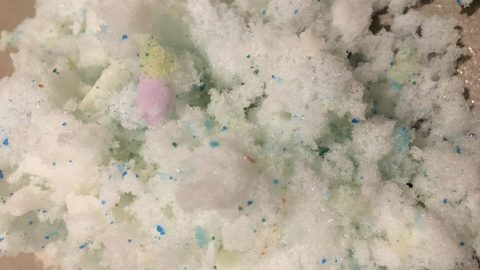 Shredded Memory Foam Pillows
Shredded Memory Foam Pillows
As its name implies, “shredded” memory foam filling is simply torn into tiny chunks. The individual pieces of foam move independently, allowing the pillow to be moldable. You can sculpt it much like a down pillow—it will shift and change into whatever shape you desire. I’ve tested shredded memory foam pillows and found them to be superior to traditional memory foam pillows.
Advantages of Shredded Memory Foam Pillows:
- doesn’t clump
- doesn’t require fluffing
- offers good support
Disadvantages of Shredded Memory Foam Pillows:
- too soft for some, particularly stomach sleepers
- potentially hazardous “off-gassing”
- builds up and retains body heat (they do, however, offer more breathability that a solid memory foam pillow)
Shredded memory foam pillows work best for back and side sleepers. Stomach sleepers might find the soft memory foam pushing uncomfortably upwards into their face.
Shredded Memory Foam Pillow Example: Coop Home Goods Shredded Memory Foam Pillow
Read More: Is a Shredded Memory Foam Pillow Better?

Buckwheat Pillows
First let me be perfectly transparent: we sell buckwheat pillows. We love these things! We’ve tried a lot of different types of pillows, and we think nothing beats an all-natural, old-fashioned buckwheat pillow. We started manufacturing these things because we thought they were the best.
Advantages of Buckwheat Pillows:
- superior support
- breathable/promotes air flow – stays cool all night
- long life-span
- moldable/malleable – it holds its shape and offers terrific support for your head, neck and shoulders
- constructed of all-natural compostable materials
Disadvantages of Buckwheat Pillows:
- buckwheat hulls make a rustling noise when shifted
- heavy — a 20×26″ buckwheat pillow weighs around 8 pounds
- too firm for some
Works best for back, side and stomach sleepers. Everybody can enjoy the benefits of a buckwheat pillow!
Buckwheat Pillow Example: Hullo Buckwheat Pillow
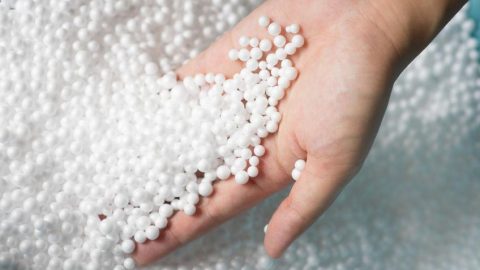
Microbead Pillows
Microbead pillows are filled with what are called “uniform polymer particles,” which, as the name suggests, look like little white beads. They are the synthetic alternative to buckwheat hull pillows and they share a lot of the same characteristics. They both promote air flow and they’re somewhat malleable as well. The most popular of these pillow types is the “Sobakawa Cloud Pillow.” This product uses a misleading name. “Sobakawa” a Japanese word for buckwheat pillow and this pillow contains no buckwheat at all. According to online reviews, microbead pillow owner satisfaction is poor. Users complain that the pillows are too firm and/or flatten after prolonged use. They are completely different from a real sobakawa pillow.
Advantages of Microbead Pillows:
- breathable-keeps cool at night
- moldable/malleable -it holds its shape and offers good support for your head, neck and shoulders
Disadvantages of Microbead Pillows:
- chemical odor and potentially dangerous “off-gassing”
- no variety of firmness or loft (they’re mostly medium firm, medium loft)
- short life span
Microbead pillows work best for back sleepers. The lack of loft variety and adjustability makes them less suitable for other sleeping positions.
Microbead Pillow Example: Sobakawa Cloud Pillow
Read more: The Microbead Pillow Will Comfortably Ruin Us All

Latex
Latex pillows are becoming quite popular. They offer good support for your head and neck while retaining a soft feel. They’re also relatively breathable providing a cool surface for your tired head. Latex pillows have an owner satisfaction rating rivaling that of our favorite type, buckwheat pillows. For that reason, I bought one for myself to try out. I had high hopes, but I was less than impressed.
Advantages of Latex Pillows:
- great support
- semi-breathable (stays cool)
Disadvantages of Latex Pillows:
- slight “rubbery” odor
- not moldable — no matter what you try, these things will bounce back into their rubbery shape
- too dense and heavy to be considered “cuddly”
They work best for side and back sleepers. Latex pillows are not recommended for stomach sleepers because most have a higher than average loft.
Latex Pillow Example: JUVEA Talalay Latex Pillow
Read more: “Rubbery Rest: A Latex Pillow Review”
Read more: “Shredded Latex Pillow Review”

Water pillow? Not as silly as I expected…
Water Pillows
Water pillows contain, you guessed it, water. Most water filled pillows are simply a plastic reservoir wrapped with polyester foam or down alternative fiberfill. Water pillows are popular due to their ability provide unchanging, solid support. I suspected water pillows were nothing more than a gimmick, but I reviewed one myself and was surprised by its effectiveness.
Advantages of Water Pillows:
- supportive — I’d say it’s a water pillow’s best attribute. Provided you’ve taken the time to fill it properly, a water pillow will consistently keeps your head elevated at just the right level all night long.
- supposed pain relief — While I wasn’t able to determine if my water pillow was indeed capable of reducing pain, but the many positive reviews online and a Johns Hopkins study are evidence of a genuine benefit.
- adjustable — Not many pillow types are adjustable. This is a huge advantage, because it can be very difficult to find the pillow that’s just right for you-they’re always either too thick or thin!
Disadvantages of Water Pillows:
- not moldable — There are no options with a water pillow-it won’t change shape. That pesky water always bounces back.
- some types may be wrapped in a fiberfill that’s too soft— My water pillow was covered in a super soft fill that pushed upward awkwardly into the side of my face.
- leaks (potentially) — I read several water pillow reviews online that mentioned leaks. A wet mattress and flat pillow aren’t conducive to good rest!
- heavy — water isn’t the lightest of pillow filling!
Water pillows are best for back sleepers. but side sleepers may appreciate them as well. Users can adjust the loft to their preference.
Water Pillow Example: Mediflow Original Waterbase Pillow
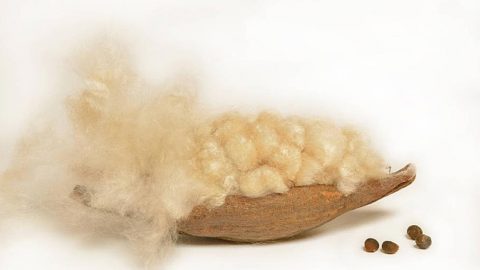
Kapok Pillows
Kapok, or ceiba pentandra, is a tropical tree native to Mexico that flowers, producing a fluffy, cotton-like material containing hundreds of seeds. This light brown, soft fibre is sometimes referred to as silk cotton.
Kapok’s qualities have made it very popular for filling pillows, upholstery, and even life preservers. Its use has dramatically declined since the introduction of polyester/polyurethane foams. Kapok is currently experiencing a small revival thanks to its all-natural characteristics. I’ve tried them myself.
Advantages of Kapok Pillows:
- free of the potentially toxic materials in many foam pillows
- cruelty-free — the practice of gathering feathers and down for use in pillows is far from humane and kapok, well… it’s not an animal!
- compostable and biodegradable
Disadvantages of Kapok Pillows:
- extremely flammable
- quickly develop lumps, much like polyester foam pillows do
- not moldable, does not hold its shape
Kapok Pillow Example: Bean Products Standard Size Organic Kapok Pillow
Kapok pillows are for all sleeping positions. Most include a zippered opening, so it’s easy to add or remove fill to your preferences.
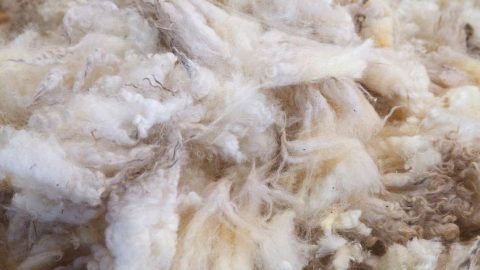
Wool Pillows
Wool’s breathable and insulative qualities make it uniquely suited for use in many different products. For thousands of years it’s been used for clothing, blankets, carpeting, insulation, upholstery and more. Wool, however isn’t extensively used as pillow filling. It has an unfortunate tendency to clump into balls, making your pillow lumpy and inconsistent.
Read More: Can a Wool Pillow Help You Sleep Better (Without Foul Odors)?
Advantages of Wool Pillows:
- free of the potentially toxic materials in many foam pillows
- breathable
Disadvantages of Wool Pillows:
- many complain of foul odors, particularly in humid environments
- with use, wool quickly becomes lumpy and uncomfortable (see above photo)
- not very moldable, does not hold its shape like down or buckwheat hull filling
- some consider wool inhumane
Wool Pillow Example: Natural Australian Wool Filled Pillow

Cotton Pillows
Given cotton’s ubiquity, one would assume that cotton-filled pillows would be reasonably popular. Popular new synthetic types of pillows like memory foam, and polyfill have changed the market. These materials have relegated cotton to a minority position.
I experimented with a cotton pillow and found it only moderately comfortable. That said, I think a cotton pillow is safe and preferable alternative to petroleum based pillow filling like memory or poly foam that is potentially toxic.
Advantages of Cotton Pillows:
- safe: cotton pillows do not contain the potentially toxic materials found in many foam pillows
- odor free
- cooler than many types of pillows like memory foam
- cruelty-free — cotton pillows contain no animal products
- compostable and biodegradable
Disadvantages of Cotton Pillows:
- with use, the filling clumps and flattens
- not moldable, does not hold its shape and thus lacks the support that some other types of pillows can provide
Cotton Pillow Example: Magnolia Organics Organic Cotton Pillow
Cotton pillows are for all sleeping positions. Most include a zippered opening, so it’s easy to add or remove fill to your preferences.
Down Alternative Pillows
Down alternative pillows attempt to mimic down’s advantages while improving upon some of down’s disadvantages.
Read More: Are Down Alternative Pillows Superior to Mother Nature’s?
Advantages of Down Alternative Pillows:
- It is far cheaper than genuine down.
- While a good down pillow can last a very long time if cared for properly, most down alternative pillows are very easy to clean without damaging them.
Disadvantages of Down Alternative Pillows:
- With use, most down alternative filling will develop lumps.
- They’re not moldable or malleable; they do not hold their shape like genuine down pillows.
- They retain more heat than traditional down pillows.
Down Alternative Pillow Example: Queen Anne Down Alternative Pillow
Down alternative pillows are best for side and back sleepers. They’re often too soft and thick for stomach sleepers.
Good luck, pillow shopper.
That’s a lot of information to wade through, but hopefully this enables you to make an informed choice for your next bed pillow. Good luck and please let us know of your favorite types of pillows in the comments below.
* Amazon Affiliate Disclosure: Hulltex LLC (dba Hullo) is a participant in the Amazon Services LLC Associates Program. This is an affiliate advertising program designed to provide a means for sites to earn advertising fees by advertising and linking to amazon.com.
Is Hullo buckwheat pillow “hard?” If your pillow isn’t properly fluffed, it can feel that way. Before you lie down, you’ll want to fluff the pillow to give it loft. This allows your pillow to conform to the shape of your head, shoulders and neck. We demonstrate how to properly fluff your pillow for maximum comfort.
